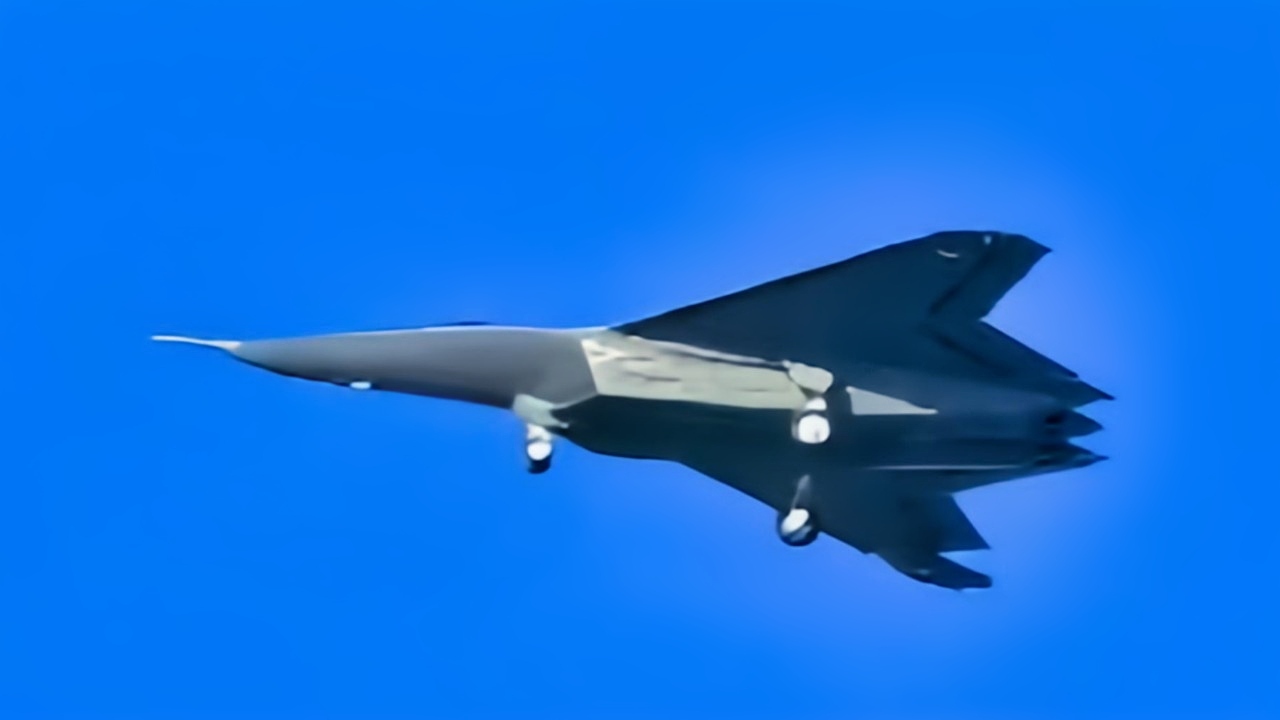Summary and Key Points: China’s J-50 fighter, notable for its lambda wing configuration, represents the PLA Air Force’s potential next-generation combat jet. Designed for high maneuverability and agility, its distinctive wings suggest optimized supersonic performance and enhanced dogfighting capabilities.
-Positioned to complement stealthier platforms like the J-20, the J-50 is likely aimed at air dominance missions and rapid-response interception.
-Despite speculative stealth characteristics, it appears to prioritize agility and aerodynamics over pure stealth, placing it possibly in the realm of semi-stealthy fifth-generation fighters.
-This combination of advanced avionics and performance hints at China’s evolving multi-layered aerial strategy, leveraging diverse aircraft to strengthen air combat capabilities.
The J-50 Fighter Mystery
The J-50 fighter jet, a recently revealed development in China’s military aviation efforts, has drawn attention for its distinctive design and potential role within the People’s Liberation Army Air Force (PLAAF).
While details remain limited and mostly speculative due to the opacity of Chinese defense disclosures, several characteristics have emerged, notably the aircraft’s use of a lambda wing configuration, which has significant aerodynamic and tactical implications.
Lambda Wings
Traditionally, Lambda wings have performed well when employed at supersonic speeds, given their relatively low drag and simplicity.
They’ve also, therefore, enjoyed good low-speed handling and a good amount of internal volume, particularly for fuel and, consequently, structural strength.
The lambda wing—named for its resemblance to the Greek letter lambda—is not quite the same as traditional delta or swept-wing designs.
The lambda wing combines a pretty forward-swept leading edge with a more conservative trailing edge sweep, resulting in a wing shape that can provide both high-speed performance and improved maneuverability and enhance close-range dogfight-type combat. Given their seeming application to the J-50, many assume that the aircraft’s focus is on agility and air superiority missions.
The J-50 is the next high-end fighter in the PLAAF’s future force structure. Though somewhat speculated, its design is intended to complement or even eventually succeed the J-10 in air superiority roles. It could also serve alongside the more stealth-focused J-20.
Although the J-20 serves as a heavy, long-range platform seemingly optimized for intercepting high-value aerial targets and striking at stand-off ranges, the J-50’s smaller frame and more aerodynamic emphasis could point to a specific role more focused on air defense, quick response, and interception of enemy aircraft as well as securing overwhelming air dominance in contested airspace.
Compare and Contrast
The J-50 is roughly analogous to the US Air Force’s F-16 in terms of both size and maneuverability.
Conversely, it could have several elements similar to the F/A-18 regarding multi-role abilities.
However, given the jet’s more modern design and the likely incorporation of advanced avionics, the J-50 could be closer to more contemporary, networked platforms like the United States F-35. There is a crucial difference.
While the F-35 emphasizes pure stealth and aerodynamics, the J-50’s lambda wing design is broadly a priority on performance, with the potential that the jet is in a slightly different tactical category, even if the airframes share generation-level features.
Interestingly, the J-50’s emergence wasn’t through official unveilings or a reveal by a top Chinese aerospace firm but rather via a series of leaks and visual information that made its way onto Chinese social media platforms and military forums. Was it planned explicitly? It’s unclear.
However, this follows a pattern of informational revelations reflected in the earlier J-35 carrier-capable stealth fighter. The unofficial nature of their reveals hints at an explicit effort to control the exposure.
As of now, the exact stealth considerations that went into the J-50 are uncertain. The jet’s airframe indicates that some considerations were taken to shape it for stealthy purposes, and some features are consistent with a low-observable design, like the jet’s edge alignment and internal weapons carriage. That being said, the jet does not place the same emphasis on stealth as the J-20 in terms of radar cross-section reduction.
Is this a balanced approach? A trade-off between stealth and agility? Unclear.
Question: Is the J-50 Fighter Really 5th Generation? Depends
China has made very rapid progress in developing stealthy aircraft in recent years. In addition to the J-20 and the navalized J-35, the J-50 may be an integral part of a multi-layered aerial strategy that uses stealth aircraft to penetrate enemy air defenses for high-value strikes.
At the same time, non-stealthy or semi-stealthy platforms engage in broader airspace patrol. This stance is somewhat similar to Western, and in particular American, air doctrine, where different generations of aircraft perform various tasks within the air defense umbrella that maximizes each jet generation’s individual abilities.
But does the J-50 qualify as a fifth-generation fighter jet? It’s a question that hinges on the jet’s systems and performance. Fifth-generation aircraft typically combine low observability, advanced sensors, high maneuverability, integrated avionics, and data fusion with other aviation and informational nodes.
If the J-50 integrates these features, it could realistically be classified as a fifth-generation aircraft, even if it lacks the full stealth suite of other aircraft.
About the Author: Caleb Larson
Caleb Larson is an American multiformat journalist based in Berlin, Germany. His work covers the intersection of conflict and society, focusing on American foreign policy and European security. He has reported from Germany, Russia, and the United States. Most recently, he covered the war in Ukraine, reporting extensively on the war’s shifting battle lines from Donbas and writing on the war’s civilian and humanitarian toll. Previously, he worked as a Defense Reporter for POLITICO Europe. You can follow his latest work on X.

